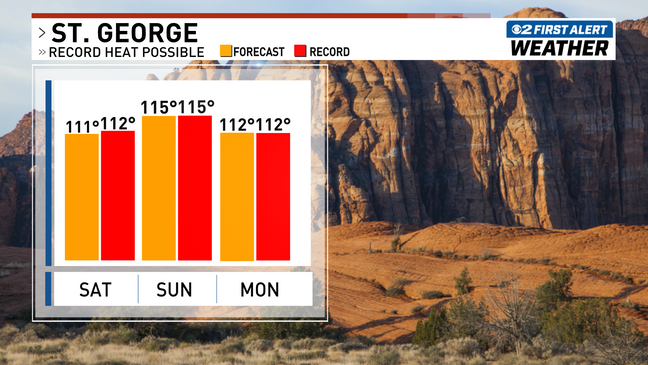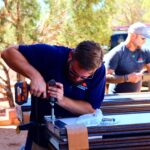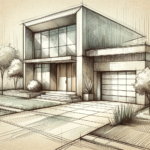What effect does heat have on a garage door?
Heat can have several effects on a garage door, depending on the materials used and the intensity and duration of the heat exposure. Here are some potential effects:
1. Expansion: When exposed to high temperatures, materials such as metal or certain types of plastic can expand. This expansion may cause the garage door panels to warp or bend, potentially leading to operational issues. For example, the door may become misaligned, making it difficult to open or close properly.
2. Paint and Finish Damage: Extreme heat can cause the paint or finish on a garage door to fade, discolor, bubble, or even peel. This is especially true if the door is exposed to direct sunlight for prolonged periods. Heat can accelerate the deterioration of the protective coatings, leading to a worn or weathered appearance.
3. Mechanical Component Stress: Garage doors comprise various mechanical components, including springs, rollers, hinges, and tracks. High temperatures can cause these components to expand and contract, putting additional stress on them. Over time, this stress may lead to wear and tear, affecting the overall functionality of the door.
4. Insulation and Energy Efficiency: Heat can impact the insulation properties of a garage door. If the door is poorly insulated or not designed to handle high temperatures, it may allow heat to enter the garage space, making it hotter inside. This can affect the garage’s energy efficiency and potentially increase cooling costs if the garage is connected to the house.
5. Electronic Systems: Modern garage doors often feature electronic systems for remote operation and safety sensors. Excessive heat can affect these components, causing malfunctions or even permanent damage. For example, the heat may interfere with the garage door opener’s electronics, preventing it from functioning correctly.
How can you minimize the effects of heat on a garage door?
To minimize the potential negative effects of heat on a garage door, it’s advisable to choose a door made from materials that can withstand high temperatures and ensure proper insulation. Regular maintenance, including lubricating moving parts and inspecting for any signs of damage, is also essential to keep the door in good working condition.
In Southern Utah, the climate can have several effects on garage doors due to the region’s unique weather patterns and conditions. Here are some specific effects to consider:
1. High Temperatures: Southern Utah experiences hot and dry summers, often exceeding 100 degrees Fahrenheit (38 degrees Celsius). Prolonged exposure to high temperatures can cause garage door materials, particularly metal, to expand. This expansion may lead to warping, misalignment, or operational issues with the door.
2. UV Radiation: The region receives intense sunlight throughout the year. UV radiation can cause damage to the surface finishes and paint on garage doors. Over time, the sun’s rays can cause fading, discoloration, and deterioration of the door’s aesthetics.
3. Low Humidity: Southern Utah has a dry climate with low humidity levels. While this may not directly impact the garage door itself, it can affect the overall garage environment. Low humidity can cause wood to shrink and dry out, potentially leading to issues with wooden garage doors, such as warping or cracking.
4. Seasonal Temperature Fluctuations: Southern Utah experiences significant temperature fluctuations between day and night, especially during the transitional seasons. These temperature swings can cause the expansion and contraction of garage door materials, potentially affecting their alignment and overall performance.
5. Dust and Sandstorms: The region is known for its desert landscape, which can lead to dust and sandstorms. These weather events can introduce fine particles into the garage, including the garage door mechanisms. Over time, this accumulation can impact the door’s smooth operation, requiring regular cleaning and maintenance.
To mitigate the effects of the climate on garage doors in Southern Utah, here are some recommended actions:
– Choose garage doors from materials that can withstand high temperatures and UV radiation, such as steel or aluminum.
– Opt for garage doors with durable finishes and paints that provide UV protection.
– Regularly clean the garage door and its mechanisms to remove dust and sand particles.
– Ensure proper insulation and weatherstripping to reduce heat transfer and maintain a comfortable garage temperature.
– Conduct routine maintenance, including lubricating moving parts, adjusting springs, and inspecting for any signs of damage or misalignment.
Considering these factors and taking appropriate measures can help protect garage doors and prolong their lifespan in the unique climate of Southern Utah.
Go Green with Insulated Garage Doors in St. George, Utah
Your garage door is most likely the largest physical entry point to your home. Ensuring your garage door is insulated will minimize heat transfer and ultimately maximize financial savings. To gain a better understanding of the importance of insulation, here is a quick rundown on the science behind heat transfer and home insulation options.
~ Source: Smart Garage
What factors play a role in garage insulation
Several factors contribute to the insulation of a garage. Here are the key factors that play a role in garage insulation:
1. Garage Door Insulation: The type and quality of insulation in the garage door itself are crucial. Some garage doors come with built-in insulation, while others may require additional insulation materials to be installed. Insulated garage doors typically have a higher R-value, which measures the material’s thermal resistance. A higher R-value indicates better insulation properties.
2. Garage Wall and Ceiling Insulation: Insulating the walls and ceiling of the garage helps prevent heat transfer through these surfaces. Common insulation materials include fiberglass batts, rigid foam boards, or spray foam insulation. The insulation should be installed properly, covering all exposed areas and any gaps or cracks that could allow air infiltration.
3. Weatherstripping and Sealing: Effective weatherstripping and sealing around the garage door, windows, and other openings are essential to prevent air leakage. Weatherstripping materials, such as rubber or vinyl, create a seal between the garage door and the frame, reducing drafts and heat transfer. Sealing gaps or cracks in the walls, ceiling, and floor further improves insulation.
4. Ventilation: Proper ventilation is important in a garage to control moisture and maintain a healthy environment. However, ventilation can also impact insulation. Insulated garage doors may have built-in ventilation options to allow airflow while minimizing heat loss or gain. It’s crucial to balance insulation and ventilation needs to achieve optimal comfort and energy efficiency.
5. Garage Design and Construction: The design and construction of the garage itself can impact insulation. Factors such as the thickness and composition of the walls, the presence of air gaps, and the type of roofing material can affect the overall insulation performance. Well-insulated exterior walls and roofs with proper air sealing can significantly improve energy efficiency.
6. Climate and Region: The local climate plays a significant role in determining the insulation requirements for a garage. Colder climates require higher insulation levels to retain heat, while warmer climates may focus more on preventing heat gain. Understanding the climate and region’s specific insulation needs is crucial for selecting the appropriate insulation materials and techniques.
7. Energy Efficiency Goals: Individual preferences and energy efficiency goals influence garage insulation choices. Some homeowners may prioritize reducing energy consumption and lowering heating or cooling costs, while others may focus on creating a comfortable working or living space within the garage. Identifying specific objectives helps tailor insulation efforts accordingly.
It’s important to consult with professionals or insulation experts to assess the specific insulation needs of your garage. They can provide guidance on the most suitable insulation materials and techniques based on factors like climate, budget, and desired outcomes.



